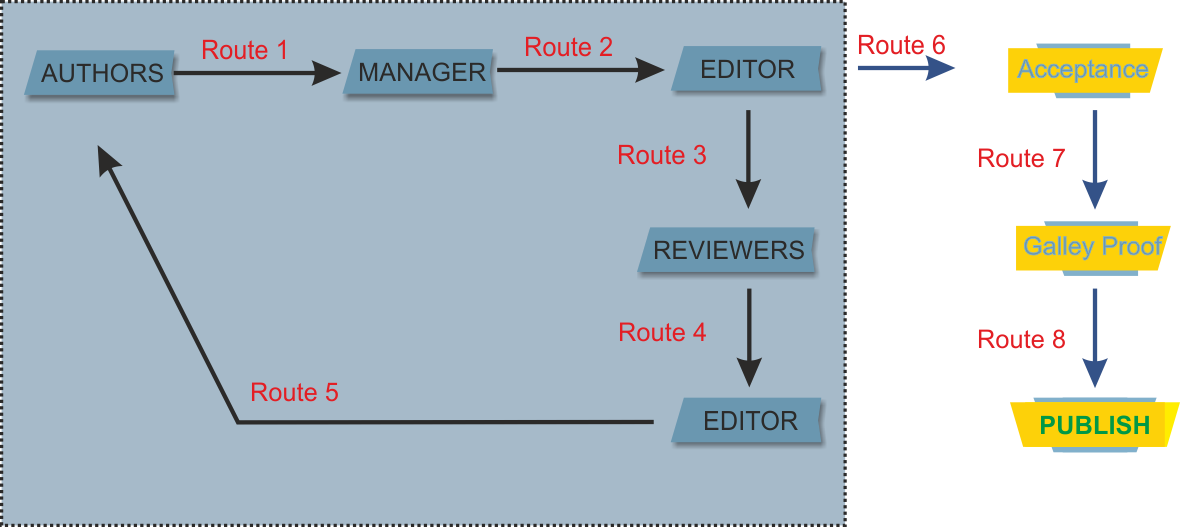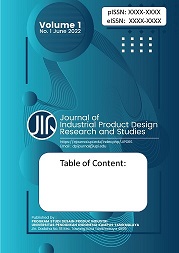- Focus and Scope
- Section Policies
- Peer Review Process
- Publication Frequency
- Open Access Policy
- Archiving
- Publication Ethics and Malpractice Statements
- Index
- Plagiarism Screening
- Fees
- Licensing
Focus and Scope
Journal of Industrial Product Design Research and Studies promotes researches in the field of design. Contributions are expected from educators, researchers, practitioners, and students at advanced stages of their research. To be published in JIPDRS, a rigorous review process will be done.
The editorial board welcomes innovative manuscripts from Design field. The scopes of this journal are
Design and Innovation
Design and Culture
Design and Aesthetic
Design Methodology
Sustainable Design
Anthropology of Design
Design Thinking
Design and Craft
Creative Industry
Bussiness Design
Design Education
Section Policies
Articles
Peer Review Process
All papers are fully peer-reviewed.We only publish articles that have been reviewed and approved by highly qualified researchers with expertise in a field appropriate (at least three reviewers per article). We used blind peer-reviewing process. Detailed information about the flow for the manuscript submission (author) to the acceptance by editor is shown in the following figure.

In short, the steps are:
- Manuscript Submission (by author) (route 1)
- Manuscript Check and Selection (by manager and editors) (route 2). Editors have a right to directly accept, reject, or review. Prior to further processing steps, plagiarism check using turtitin is applied for each manuscript.
- Manuscript Reviewing Process (by reviewers) (route 3-4)
- Notification of Manuscript Acceptance, Revision, or Rejection (by editor to author based on reviewers comments) (route 5)
- Paper Revision (by author)
- Revision Submission based on Reviewer Suggestion (by author) with similar flow to point number 1. (route 1)
- If reviewer seems to be satisfied with revision, notification for acceptance (by editor). (route 6)
- Galley proof and publishing process (route 7 and 8)
The steps point number 1 to 5 is considered as 1 round of peer-reviewing process (see grey area in the figure). And, our reviewing process at least goes through 2 round of reviewing process.
The journal editor or editorial board considers the feedback provided by the peer reviewers and arrives at a decision. The following are the most common decisions:
(i) accept without any changes (acceptance): the journal will publish the paper in its original form
(ii) accept with minor revisions (acceptance): the journal will publish the paper and asks the author to make small corrections
(iii) accept after major revisions (conditional acceptance ): the journal will publish the paper provided the authors make the changes suggested by the reviewers and/or editors
(iv)revise and resubmit (conditional rejection): the journal is willing to reconsider the paper in another round of decision making after the authors make major changes
reject the paper (outright rejection): the journal will not publish the paper or reconsider it even if the authors make major revisions
Publication Frequency
Journal of Industrial Product Design Research and Studies publishes twice a year in June and December. Each publication consists of 5-10 research articles.
Open Access Policy
This journal provides immediate open access to its content on the principle that making research freely available to the public supports a greater global exchange of knowledge.
The published articles are licensed under the Creative Commons Attribution-ShareAlike 4.0 International License.
Archiving
This journal utilizes the LOCKSS system to create a distributed archiving system among participating libraries and permits those libraries to create permanent archives of the journal for purposes of preservation and restoration. More...
Publication Ethics and Malpractice Statements
Journal of Industrial Product Design Research and Studies is a peer-reviewed electronic and printed journal. To that extent, it clarifies the ethical behaviour of all parties involved in the article publication of Journal of Industrial Product Design Research and Studies including the authors, the chief editors, the Editorial Boards, the peer-reviewers and the publishers (Universitas Pendidikan Indonesia). This statement is based on COPE’s Best Practice Guidelines for Journal Editors.
The Editorial Board is responsible, among the others, for deciding which of the research papers/articles submitted to the journal should be published and preventing publication malpractice. Unethical behavior is unacceptable and the Journal of Industrial Product Design Research and Studies does not tolerate plagiarism in any form.
1. Editors' Responsibilities
Publication Decisions: Editors should be accountable for everything published in their journals and must strive to meet the needs of readers and authors. Editors’decisions to accept or reject a paper for publication should be based on the editorial board’s reviews and the paper’s importance.
Review of Manuscripts: The editor must ensure that each manuscript is initially evaluated by the editor, who may make use of appropriate means, to examine the originality of the contents of the manuscript and ensure the quality of the material they publish, recognizing that journals and sections within journals will have different aims and standards.
Fair Review: Editors should strive to ensure that peer review at their journal is fair, unbiased and timely. The editor ensures that each manuscript received is evaluated on its intellectual content without regard to authors’ sex, gender, race, religion, citizenship, etc.
Confidentiality: The editor and any editorial staff must not disclose any information about a submitted manuscript to anyone other than the corresponding author, reviewers, potential reviewers, other editorial advisers, and the publisher, as appropriate. The editor must ensure that information regarding manuscripts submitted by the authors is kept confidential.
Disclosure and Conflicts of Interest: Editors should require reviewers to disclose any potential competing interests before agreeing to review a submission
2. Author’s Responsibilities
Reporting Standards: Authors should precisely present their original research, as well as objectively discuss its significance. Manuscripts are to be edited in accordance with the author guidelines.
Originality: Authors must certify that their work is entirely unique and original.
Redundancy: Authors should not concurrently submit papers describing essentially the same research. Submitting the same paper to more than one journal constitutes unethical publishing behavior and is unacceptable.
Acknowledgement of Sources: Author(s) should acknowledge all sources of data used in the research and cite publications that have influenced their research.
Authorship of the Paper: Authorship should be limited only to those who have made a significant contribution to conceiving, designing, executing and/or interpreting the submitted study. All those who have significantly contributed to the study should be listed as co-authors. The corresponding author should also ensure that all the authors and co-authors have seen and approved the final submitted version of the manuscript and their inclusion as co-authors.
Data Access and Retention: Authors should retain raw data related to their submitted paper, and must provide it for editorial review, upon request of the editor.
Fundamental Errors in Published Works: When an author discovers a significant error or inaccuracy in his/her submitted manuscript, the author must immediately notify the editor.
3. Reviewers' Responsibilities
Confidentiality: Manuscript reviewers, the editor, and the editorial staff must not disclose any information regarding submitted manuscripts. All submitted manuscripts are to be treated as privileged information. Editors should provide guidance to reviewers on everything that is expected of them including the need to handle submitted material in confidence.
Acknowledgement of Sources: Reviewers must ensure that authors have acknowledged all sources of data used in the research. Any statement that an observation, derivation, or argument had been previously reported should be accompanied by the relevant citation. A reviewer should also call to the editor's attention any substantial similarity or overlap between the manuscript under consideration and any other published paper of which they have personal knowledge.
Standards of Objectivity: Reviews of submitted manuscripts will be conducted objectively. The reviewers shall express their views clearly, with supporting arguments. Personal criticism of the author is inappropriate.
Promptness: If a reviewer believes it is not possible for him/her to review the research reported in a manuscript within the designated guidelines, or within the stipulated time, he/she should notify the editor, so that an accurate and timely review can be ensured.
Conflict of Interest: All reviewers should have no conflict of interest with respect to the research, the authors and/or the funding bodies.
4. Change or Modification of Published Paper
Withdrawal: Papers published will be withdrawn if the author(s) noticed significant errors. Before accepting a withdrawal request, the editorial board and Editor-in-chief should talk with the author(s) sufficiently. If the paper was agreed to be withdrawn, the following will be implemented:
- The paper in the journal database will be removed.
- The link in the online publication site will be removed.
- The next phrase or similar phrase stating the reason will be shown below the paper title in the Table of Contents and journal volume page: (This paper was withdrawn because of some technical errors).
Replacement: Papers published can be replaced if the author(s) send an updated paper. Before accepting a replacement request, the editorial board and Editor-in-chief should talk with author(s) sufficiently, and at least reviewers should check the advances. If the paper was agreed to be replaced, the following will be implemented:
- The paper in the journal database will be replaced.
- The link in the online publication site will be replaced.
- The next phrase or similar phrase stating the reason will be shown below the paper title in the Table of Contents and journal volume page: (This paper was replaced because the author(s) sent an updated version. Contact the editor if you want to check the old version).
- The old version should be kept separately, and if someone wants to check the old version, the editor can send the PDF to him/her.
- Note that the replacement is acceptable only one time, and only for the technical advances.
Removal: Papers published will be removed if reviewers, readers, librarians, publishers or other subjects noticed significant errors or plagiarism. Before removing a paper, the editorial board and Editor-in-chief should talk with authors sufficiently and should provide enough time to have author(s)’ explanations. If the paper was agreed to be removed, the following will be implemented:
- The paper in the journal database will be removed.
- The link in the online publication site will be removed.
- The next phrase or similar phrase stating the reason will be shown below the paper title in theTable of Contents and journal volume page: (This paper was removed because of plagiarism).
5. Penalties
Double Submission: If the double submission was found or noticed from other sources, the editorial board should check the status. If the double submission was confirmed as an intentional thing,
- The review process will be terminated.
- The reason should be sent to reviewers, editorial board and authors.
- All authors’ names will be marked as blacklisted, and these authors cannot submit any paper to JPJO for five years.
Double Publication: If the double publication was found or noticed from other sources, the editorial board should check the status. If the double publication was confirmed as an intentional thing,
- This will be reported to the editorial board and author(s).
- This will be sent to the publisher who published the same (or very similar) paper.
- Paper will be removed according to the “Removal” part in Section 4.
- All author(s)’ names will be marked as blacklisted, and these authors cannot submit any paper to JIPDRS for five years.
Plagiarism Screening
Plagiarism Screening
Before going to review process, all manuscripts will be checked that they are free from plagiarism practice (less than 20% similarities). If there an indication of plagiarism (higher than 20% similarities), the manuscript will instantly be rejected.
Fees
There are no submission and article processing charges
Licensing

JIPDRS is licensed under a Creative Commons Attribution-ShareAlike 4.0 International License.


